
Biometrical Letters Vol. 44(1), 2007, pp. 51-70


Fly ashes from Municipal Solid Waste Incinerators (MSWI) are considered hazardous waste where current practice is to deposit them in landfill. The Electrodialytic Process (EDR) is a remediation technique, which was first applied in contaminated soil remediation. The principle combines electric current with dialysis and aims to remove heavy metals from contaminated solid media. In the present study, an eighteen electrodialytic experiment batch was carried out with different combinations of variables with presumed influence on EDR. Variables such as "Ash %", "Current", "Duration", "Length" and "Metal" were considered. The level of significance of each variable for general EDR performance was determined by F tests and Scheffé's multiple comparison method. It was possible to build up a gradated sequence for the variables "Current" and "Ash %". For a general analysis, linear regressions and F tests were carried out individually for each variable to study its influence on the removal of each studied metal (Fe, Mn, Cu, Zn, Cd, Cr, Pb and Ni). "Length" was found to be the variable with the most effect on EDR efficiency, followed by "Ash %". Furthermore a multiple regression design approach was used to evaluate EDR performance throughout the remediation time. It might be concluded that a given variable affects the removal of the metal by positive or negative species.

Electrodialytic Process, F tests, Fly ash, Multiple regression design, Scheffé multiple test

